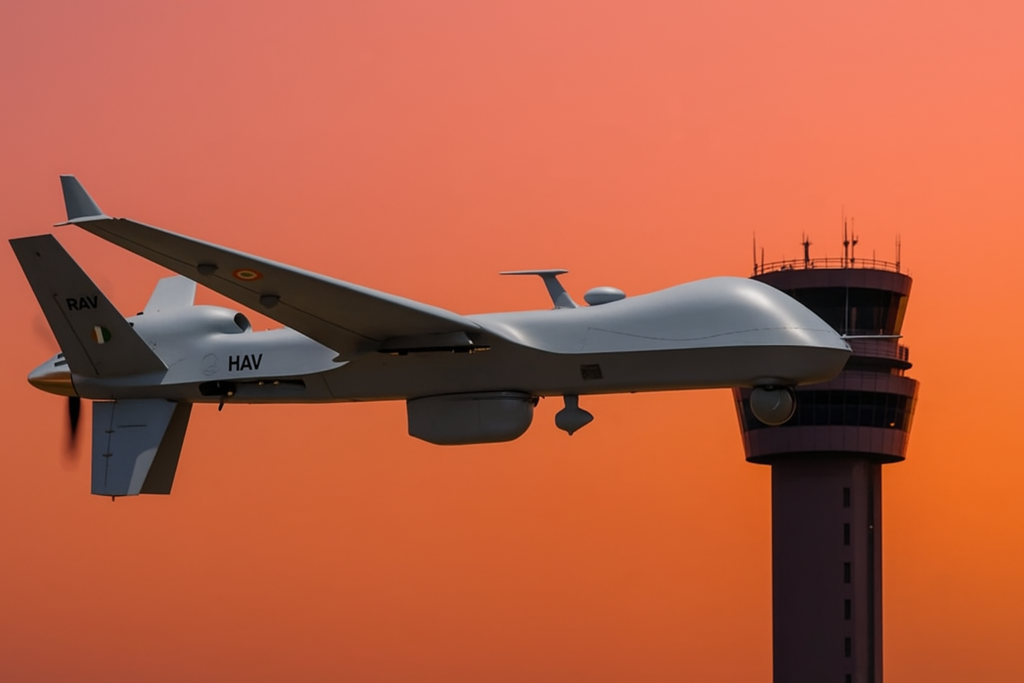The Indian MALE UAV represents a vital stage in the evolution of India’s unmanned aviation capability. It acts as the fundamental building block for more advanced HALE systems. A Medium Altitude Long Endurance platform primarily depends on five crucial technological pillars. These include the propulsion system, aerostructures, avionics and ATOL, hydraulic actuation systems, and the SATCOM-enabled data link network.

Each component defines the overall performance envelope of the UAV. The aerostructure determines the aerodynamic efficiency and endurance. The engine governs altitude ceiling and power-to-weight ratio. The avionics and ATOL systems ensure mission reliability and autonomous functionality. Hydraulics manage flight control surfaces and payload actuation. Finally, the SATCOM link establishes continuous command and control connectivity even beyond line-of-sight operations.
Technical Architecture and Value Composition
No aerospace company willingly transfers its proprietary technology. This restriction applies strongly to propulsion systems, flight computers, and mission management software. However, nearly 50–60% of the UAV’s total value resides in aerostructures and integration-heavy subsystems. India’s procurement policy allows foreign OEMs to supply systems if 50–60% of the content is indigenous. However, foreign manufacturers often meet this threshold through low-technology, high-cost aerostructure assemblies. This approach inflates the local value content on paper while shielding core technologies such as propulsion, avionics, and mission software. As a result, the actual transfer of critical know-how remains minimal, even though the project formally qualifies as indigenized.

Indian industry already possesses these capabilities. Domestic firms manufacture composite airframes, titanium spars, servo-hydraulic actuators, and mission-level electronics. Integrating these into a single unified platform requires system engineering discipline and robust project management. When executed correctly, this integration creates a sovereign UAV ecosystem where the majority of cost and expertise remains indigenous.
Why MALE UAVs Are Foundational Systems
A MALE UAV is not the ultimate technology frontier. Instead, it acts as a transitional platform that trains industries and engineers for higher-end HALE systems (while serving as a cost effective long endurance ISR platform). The aerodynamic configurations, propulsion management, and power distribution architecture developed for MALE drones can easily scale to advanced designs. The avionics architecture also evolves into modular frameworks compatible with future stealth or even hybrid solar-powered UAVs.

Moreover, operating a domestic MALE UAV fleet allows continuous feedback from mission data. Engineers can refine control algorithms, optimize composite structures for fatigue life, and enhance SATCOM encryption. This iterative learning accelerates both technological depth and operational maturity.
Need for a Complete Development Cycle
India has previously relied on emergency purchases to meet urgent surveillance requirements. Such procurements fulfill short-term operational needs but hinder long-term technological independence. A complete development cycle ensures deep integration of design, testing, certification, and lifecycle maintenance.

In this model, a private firm acts as the system integrator. It coordinates multiple vendors producing engines, actuators, and electronic subsystems. The government provides funding, regulatory guidance, and test facilities. This dual framework allows faster development, better accountability, and efficient risk management. It also prevents technology fragmentation between public and private sectors.
Subsystem Focus and Modular Integration
To ensure steady progress, engineers must modularize the UAV architecture. The propulsion module should use a turbodiesel or turboprop engine (later for HALE) with redundant FADEC control. The avionics module must follow an open architecture protocol, allowing easy sensor or datalink upgrades. Hydraulic systems should adopt electro-hydraulic servo actuation for precise control.
The aerostructure should employ carbon fiber reinforced polymer composites with honeycomb cores to maintain low radar cross-section and high endurance. SATCOM and Datalink systems should comply with MIL-STD-810H and AES-256 encryption standards. Such modularity enables parallel subsystem development and faster integration during final assembly.
From MALE to HALE: The Logical Progression
Developing the Indian MALE UAV is not an isolated goal. It establishes the design methodology, supply chain discipline, and certification culture necessary for HALE systems. The same propulsion integration, airframe design philosophy, and flight control algorithms can scale upward for higher altitude, longer endurance platforms.

Additionally, the data link and SATCOM systems developed for MALE class drones create the backbone for network-centric warfare operations. These advancements prepare India for autonomous swarm systems and manned-unmanned teaming.
India already possesses the industrial and technological base required to build a complete MALE UAV system. What remains essential is structured program management and system integration under a capable private lead. By executing a full development cycle, India can shift from dependency to design leadership. The Indian MALE UAV can, therefore, become the cornerstone of future HALE and combat UAV programs — a true engineering milestone for the nation’s aerospace ecosystem.

Times are such, necessary adjustments are required. In current situation collaboration is better than imports. Can’t wait for our systems to develop and mature.
Even China started with screwdrivers and subsequently scaled it’s systems. It is natural cycle for manufacturing.